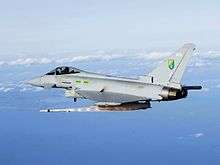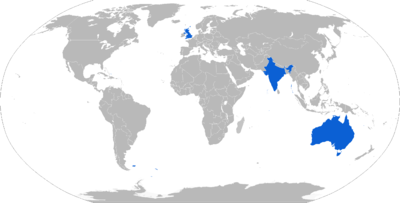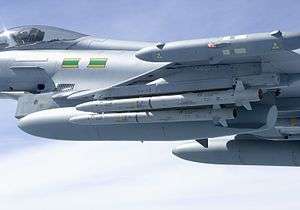ASRAAM
| Advanced Short Range Air-to-Air Missile | |
|---|---|
|
Two ASRAAM (centre) on a RAF Typhoon in 2007 | |
| Type | Short-range air-to-air missile |
| Place of origin | United Kingdom |
| Service history | |
| In service | 1998 |
| Used by | RAAF , RAF, IAF |
| Production history | |
| Manufacturer | MBDA |
| Unit cost | >£200,000 |
| Specifications | |
| Weight | 88 kg |
| Length | 2.90 m |
| Diameter | 166 mm (motor diameter)[1] |
| Warhead | 10 kg blast/fragmentation |
Detonation mechanism | laser proximity fuze and impact |
|
| |
| Engine | dual-burn, high-impulse solid rocket motor[2] |
| Wingspan | 450 mm |
Operational range |
Air-launched: 300 m – 50 km (officially in excess of 25km) [3][4] Vertically-launched: >25km[5] |
| Flight altitude | N/A |
| Speed | Mach 3+[6] |
Guidance system |
Air-launched: infrared homing, 128×128 element focal plane array, with lock-on after launch (LOAL) and strapdown inertial guidance[6] Vertically-launched: Active RF homing. |
Launch platform |
Aircraft: |


The Advanced Short Range Air-to-Air Missile, also known by its United States identifier AIM-132, is an imaging infrared homing ("heat seeking") air-to-air missile, produced by MBDA. It is currently in service in the Royal Air Force (RAF) and Royal Australian Air Force (RAAF), replacing the AIM-9 Sidewinder. ASRAAM is designed to outrange and outrun any other IR missile in service, allowing the pilot to fire and then turn away long before the opposing aircraft can close for a shot. It flies at well over Mach 3 to ranges as great as 50 kilometres (31 mi), well over double the range of earlier designs. It retains a 50g manoeuvrability provided by body lift technology coupled with tail control.[7][8]
The project started as a British-German collaboration in the 1980s. It was part of a wider agreement in which the US would develop the AIM-120 AMRAAM for medium-range use, while the ASRAAM would replace the Sidewinder with a design that would cover the great range disparity between Sidewinder and AMRAAM. Germany left the programme after examining the latest Soviet designs of the 1980s, deciding that a missile with far greater short-range maneuverability was more important than range. The British proceeded on their own, and the missile was introduced into RAF service in 1998. It has since been selected to replace Sidewinder in the Royal Australian Air Force and is being introduced to the Indian Air Force.
History
Prior work
The first extensive use of IR missiles took place during the Vietnam War, where the results were dismal. The AIM-4 Falcon, the USAF's primary missile, scored hits only 9% of the time it was fired. The US Navy's AIM-9 Sidewinder fared only slightly better, achieving hits in 14 to 19% of firings, depending on the model. It became clear that the primary issue was that the pilots were firing as soon as the missile saw the target in the seeker, any time it was in front of the launch aircraft. However, the seekers had a very limited field of view so if the target aircraft was flying at right angles to the launcher, it would fly out of the seeker's view even as it left the launch rail.
An attempt to address this problem was made starting in the late 1960s by the Hawker Siddeley "Taildog", initially a private project but later officially supported as SRAAM. SRAAM's basic premise is that if pilots wanted to fire when the target was anywhere in front, then the missile should work in those situations. The result was a very short range but extremely maneuverable weapon that could turn rapidly enough to keep the target in view no matter the launch parameters. However, by 1974 the program had been downgraded to a pure development project, and was later cancelled. The US stated a similar project, AIM-95 Agile, to arm the new F-14 and F-15. This was similar to SRAAM in concept, but somewhat larger in order to offer range about the same or better than Sidewinder. Development was cancelled in 1975. Meanwhile, an entire different set of criteria led to the Dornier Viper, whose design maximized range.[9]
The main reason these projects were cancelled was that a new version of the Sidewinder was introduced (the AIM-9L) which added all-aspect capabilities and wider seeker angles. A variety of changes gave the L slightly better maneuverability, speed and range but the main change was that the seeker had much higher tracking angles and allowed head-on engagements. Although not nearly as great a step forward as the other designs, the "Lima" offered a significant improvement in capability over the older models for very little additional cost. British pilots achieved an 80% kill ratio with the L model during the Falklands War, a number matched by the Israeli Air Force a few months later over the Bekaa Valley. US experience with the Sidewinder since then has been mixed, with a percentage kill of just under 60% for the F-15, but almost zero for F-16s and F-18s, which suggests pilot training is the primary factor in success.[10]
AMRAAM and ASRAAM
In a series of tests in the mid-1970s, the USAF found that their existing AIM-7 Sparrow missile had an effective range against fighter targets no better than the ostensibly much shorter-range Sidewinder. This was due to the need for the launching aircraft to keep flying towards the target in order to allow its radar to continue illuminating the target. During the time the missile was flying, the target aircraft was closing the distance, and had the chance to launch their IR missiles before being hit. This resulted in mutual kills, obviously undesirable.[11]
The Fighter Mafia examined these results and concluded that they proved what they had been saying all along: a smaller, cheaper aircraft armed with simple but effective weapons is just as good as a more complex and expensive system, but could be purchased in greater numbers.[11] The USAF looked at the same results and concluded the solution was to design a new, expensive and complex weapon to replace the Sparrow. The primary aims were to extend the range to keep the IR-guided missile firing fighters out of launching range, the use of an active seeker to allow the launching fighter to turn away, and, if possible, to reduce the weight enough to allow it to be carried on launchers designed only for the Sidewinder. The result was the AIM-120 AMRAAM project, with the initial versions having a range of 50 to 75 km.
The AMRAAM also presented a new problem: between the Sidewinder's short range and AMRAAM's long range was a significant gap. Moreover AMRAAM was not really intended to be a snap-shot weapon like the Sidewinder, which remained desirable, and the completely passive attack of a heatseeker can be an enormous advantage in combat. A new IR guided missile designed to act as a counterpart to AMRAAM would be a very different design than the AIM-9L, which had always been intended solely as a stop-gap measure. In the 1980s, NATO countries signed a Memorandum of Agreement that the United States would develop the AMRAAM, while a primarily British and German team would develop a short-range air-to-air missile to replace the Sidewinder. The complete team included the UK (Hawker Siddeley, by this point known as BAe Dynamics) and Germany (Bodensee Gerätetechnik) sharing 42.5% of the effort each, Canada at 10%, and Norway at 5%. The US assigned this missile the name AIM-132 ASRAAM.[12]
New ASRAAM
The rapid decline and eventual fall of the Soviet Union in the late 1980s led to considerably less interest in the ASRAAM effort. As well, German reunification gave the German Air Force their first look at the Russian Vympel R-73 missile, known in the west as the AA-11 Archer. This proved to be a far more dangerous short-range attack weapon than had been known previously. It was clearly able to outperform all operational Western short-range IR tracking missiles, particularly in the ability to guide in high off-axis attacks, but also in terms of field of view, acquisition range, maneuverability, ease of target designation, and target lock-on.[12]
By February 1988 the US was already agitating for changes. In July 1989 the Germans exited the program, deciding that much greater maneuverability was required to compete with the R-73. This left Britain in control of the program and they began redefining it purely to RAF needs, sending out tenders for the new design in August 1989. This led to the selection of a new Hughes focal plane array imaging array seeker instead of the more conventional design previously used, dramatically improving performance and countermeasure resistance. A UK contest in 1990 examined the new ASRAAM, the French MICASRAAM and a new design from Bodensee Geratetechnik, their version of the ASRAAM tuned for German needs. In 1992 the Ministry of Defense announced that ASRAAM had won the contest, and product began in March that year. The German design, now part of Diehl BGT Defence, became the IRIS-T.[12]
While ASRAAM was entering production, the US had decided that they too desired better turning performance and found the British unwilling to commit to further changes. At the same time, the strengthening European economy and the resulting changes in exchange rates made the ASRAAM less financially attractive. Using some work carried out by the Navy, the Air Force then began their own program, AIM-9X, selecting the same Hughes seeker as the new ASRAAM. In January 1995 British Aerospace Dynamics arranged for financing from the British Government to enter the ASRAAM in the AIM-9X contest. The testing concluded in June 1996, with the result that the ASRAAM did not meet the US requirements.
UK development and manufacture went ahead and the first ASRAAM was delivered to the RAF in late 1998. It equips the RAF’s Tornado GR4 and Typhoon. It was also used by the RAF's Harrier GR7 force until its retirement. In February 1998 ASRAAM was selected by the Royal Australian Air Force for use on their F/A-18 Hornets following competitive evaluation of the improved ASRAAM, the Rafael Python 4 and the AIM-9X.[13] In March 2009 the Royal Australian Air Force successfully carried out the first in-service ‘Lock on After Launch’ firing of an ASRAAM at a target located behind the wing-line of the ‘shooter’ aircraft.[14]
Description
Characteristics
Whereas IRIS-T and AIM-9X concentrate on short-range maneuverability, like the SRAAM and Agile before them, ASRAAM represents a different design philosophy. ASRAAM is intended to detect and launch against targets at much longer ranges, as far as early versions of the AMRAAM, in order to shoot down the enemy long before it closes enough to be able to fire its own weapons. In this respect the ASRAAM shares more in common with the AMRAAM than other IR missiles, although it retains high maneuverability. To provide the needed power, the ASRAAM is built on a 6½ inch diameter rocket motor compared with Sidewinder's (AIM-9M and X) and IRIS-T's 5 inch motors (which trace their history to the 1950's unguided Zuni rocket). This gives the ASRAAM significantly more thrust and therefore increased speed and range up to 50 km.[3]
The main improvement, which was also made on the latest version of the AIM-9 Sidewinder, is a new 128×128 resolution imaging infrared focal plane array (FPA) seeker manufactured by Hughes before they were acquired by Raytheon. This seeker has a long acquisition range, high countermeasures resistance, approximately 90 degrees off-boresight lock-on capability, and the possibility to designate specific parts of the targeted aircraft (like cockpit, engines, etc.).[15] The ASRAAM also has a LOAL (Lock-On After Launch) ability which is a distinct advantage when the missile is carried in an internal bay such as in the F-35 Lightning II. The ASRAAM warhead is triggered either by laser proximity fuse or impact. A laser proximity fuse was selected because RF fuses are vulnerable to EW intervention from enemy jammers.[16]
ASRAAM P3I
In 1995, Hughes and British Aerospace collaborated on the "P3I ASRAAM", a version of ASRAAM as a candidate for the AIM-9X program. The P3I would have been very much like the AIM-132, but with the addition of thrust vectoring to provide increased agility and to carry a larger warhead to meet the requirements expressed by the US Navy led AIM-9X program. The ultimate winner was the Hughes submission using the same seeker but with the rocket motor, fuze and warhead of the AIM-9M. The latter was a US Air Force stipulation to ease the logistics burden and save by reusing as much as possible of the existing AIM-9 Sidewinder, of which 20,000 remained in the US inventory.
Future development
At the DSEi conference in September 2007 it was announced the UK MoD was funding a study by MBDA to investigate a replacement for the Rapier and Sea Wolf missiles. The Common Anti-Air Modular Missile (CAMM) would share components with ASRAAM.[17] Common components include the very low signature rocket motor from Roxel, the warhead and proximity fuse from Thales. The Common Data Link (CDL) is the small ‘black box’ that sits on top of the mast, especially clear in pictures of FLAADS(L) although it doesn’t necessarily have to use the two-way data link to the launch vehicle, so, it could take mid-course corrections from any number of suitably equipped land or air platforms and then switch to active homing when it gets close enough. The original launch platform could have even moved by the time the missile hits.[18]
MBDA has agreed to jointly develop a new generation air-to-air missile with India.[19]
In August 2016, the UK's MOD signed a contract for a new variant of the ASRAAM specifically for the UK's F-35B. This variant would replace the current one when it goes out of service in 2022. This new variant will be operationally ready on the Eurofighter Typhoon in 2018 and on the UK's F-35Bs from 2022 onwards.[20][21][22]
Operators

Current operators
 United Kingdom
United Kingdom- Royal Air Force
 Australia
Australia- Royal Australian Air Force
 India
India- Indian Air Force; on 8 July 2014 India & UK signed a deal to procure 384 ASRAAM from MBDA to replace the ageing Matra Magic R550, to be integrated onto the SEPECAT Jaguar strike aircraft.[23]
See also
References
Citations
- ↑ Asraam background (PDF), MBDA.
- ↑ "Asraam", RAF, MoD.
- 1 2 "ASRAAM". Youtube (documentary). Science & Technology. Retrieved 2009-07-10.
- ↑ "MOD signs £184 million contract to secure air-to-air missiles for the F-35B". Royal Navy. 16 August 2016. Retrieved 16 August 2016.
- ↑ http://www.mbda-systems.com/camm-solution/camm/
- 1 2 "AIM-132 ASRAAM". FAS. Retrieved 2011-12-12.
- ↑ "Asraam", Typhoon, Star streak.
- ↑ Asraam background (PDF), MBDA.
- ↑ "Dornier Viper abandoned", Flight International: 847, 27 June 1974
- ↑ Hollway, Don (March 2013). "Fox Two!". Aviation History.
- 1 2 Correll, John (February 2008). "The Reformers". Air Force Magazine.
- 1 2 3 Kopp 1998.
- ↑ "Matra-BAe AIM-132 ASRAAM: The RAAF's New WVR AAM". Air Power Australia. Retrieved 2011-12-12.
- ↑ "RAAF has successfully fired ASRAAM at a target located behind the wing-line of the 'shooter' aircraft". Your Industry News. 2009-03-09. Retrieved 2009-03-10.
- ↑ http://defense-update.com/newscast/0309/asraam_loal_test_130309.html
- ↑ You tube, Google.
- ↑ "Missiles and Fire Support at DSEi 2007", Defense update.
- ↑ http://www.thinkdefence.co.uk/uk-complex-weapons/common-anti-air-modular-missile/
- ↑ "Air Weapons: The Magic Is Gone". Strategy page. 2010-02-18. Retrieved 2011-12-12.
- ↑ "MOD signs £184 million contract to secure air-to-air missiles for the F-35B". Royal Navy. 16 August 2016. Retrieved 16 August 2016.
- ↑ "Britain Stockpiles New ASRAAM Missiles for the F-35". Defensenews.com. 16 August 2016. Retrieved 17 August 2016.
- ↑ "UK orders ASRAAMs to arm F-35s". IHS Janes. 17 August 2016. Retrieved 17 August 2016.
- ↑ "India, UK sign deals worth 370 million", Live Mint.
Bibliography
- Kopp, Carlo (December 1998). "Matra-BAe AIM-132 ASRAAM - The RAAF's New WVR AAM". Air Power International.
External links
| Wikimedia Commons has media related to AIM-132 ASRAAM. |
- ASRAAM, MBDA.
